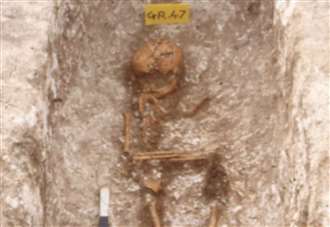The earliest evidence of Black African ancestry in Britain and Europe has been found in Kent in a remarkable discovery by archaeologists.
DNA testing found that a girl buried at an early medieval cemetery in Updown, near Eastry, Deal, some 1,300 years ago, was of sub-Saharan descent.

The discovery was made just 900 metres from the site of a royal palace belonging to the Anglo-Saxon kings of Kent.
Researchers say the 12-year-old girl, who died in the first half of the 7th century, was laid to rest with a knife, spoon, bone comb and fine decorated pot, suggesting she belonged to a high-status family connected to Kent’s ruling elite.
Her DNA, which has been exceptionally well preserved, shows she had brown eyes, dark hair and a Mediterranean or North African complexion – a striking contrast to the pale skin, fair hair and blue eyes common among Anglo-Saxon nobility.
Archaeologists believe her Nigerian grandparent, likely a woman, may have been brought to Europe via a Saharan slave trade route in the late 6th century, before arriving in Kent through links with France.
The study, published in the UK archaeological journal Antiquity, was led by an Anglo-German team with tests carried out at the Max Planck Institute in Leipzig and the University of Huddersfield.
It also examined a second burial of a teenager in Dorset with similar ancestry.

Both youngsters were descended from grandparents from what is now southern Nigeria, yet were buried hundreds of miles apart in the same era.
Prof Duncan Sayer, from the University of Central Lancashire, said: “It is significant that it is human DNA – and therefore the movement of people, and not just objects – that is now starting to reveal the nature of long-distance interaction to the continent, Byzantium and sub-Saharan Africa.”
In the 7th century, Kent was a gateway between England and mainland Europe, with close ties to French royalty.
Historians note that in 6th century France, it was not unheard of for nobles – even royalty – to marry enslaved people from distant lands to avoid powerful in-laws, while also projecting a cosmopolitan image.
The girl’s lifetime coincided with Kent’s conversion to Christianity in 597AD, an event that shaped English history.
Researchers suggest her family may have been part of the influx of French-linked elites who played a role in that transformation.
